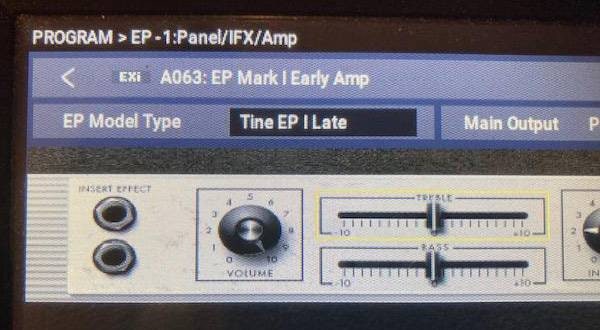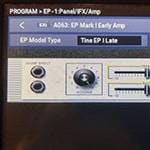Speaking of truss rods, they are metal rods built inside the necks of guitars or basses, and a part mainly used for reinforcing the neck and correcting warpage, but you know, there’s more to it than that. This time, I would like to talk about the various depths of the "truss rod".
1. Truss rod principle
As I wrote at the beginning, the important role of the truss rod is to "correct the warpage of the neck". Basically, when the nut on the truss rod is tightened, it moves in the reverse warp direction (forward warp → reverse warp), and when it is loosened (= reverse rotation), it moves in the forward warp direction (reverse warp → forward warp), but why does such a movement occur just by turning the nut attached to the metal rod? For the sake of clarity, I will explain using illustrations using the one-way (one-handed) type as an example.
First, split the acoustic guitar neck in half from the center line.

It looks like this. In this state, the truss rod is not shown yet, so I will try to prepare that immediately.

Here we go. The gray part that was not shown in the previous figure is the truss rod, and the milky white part above it is the filling wood for fixing the truss rod. As you may have noticed, the truss rod is not straight. Actually, this is the knack of this type of truss rod, and it is effective only when it is made in a curved state. By tightening the nut at the tip of the rod with a wrench, a force is generated that pulls the truss rod embedded in the bent state from both ends. As a result, the truss rod approaches a straight state, and the neck moves in the reverse warp direction.
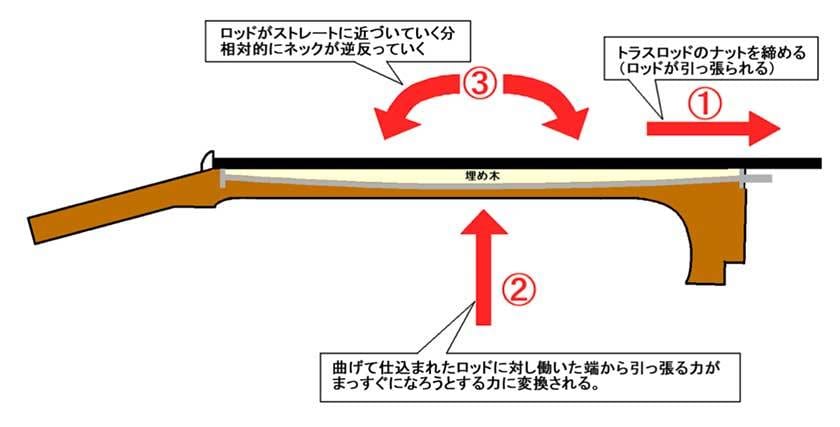
This is the most primitive 1-way (single-handed) type truss rod operating principle.
2. Types of truss rods
I used the term one-way type earlier, but of course there are also ambidextrous types. There are various other types of truss rods, including the one-way. Let's take a look at some of the mainstream rods that are available.
2-1. One-way type (single action)
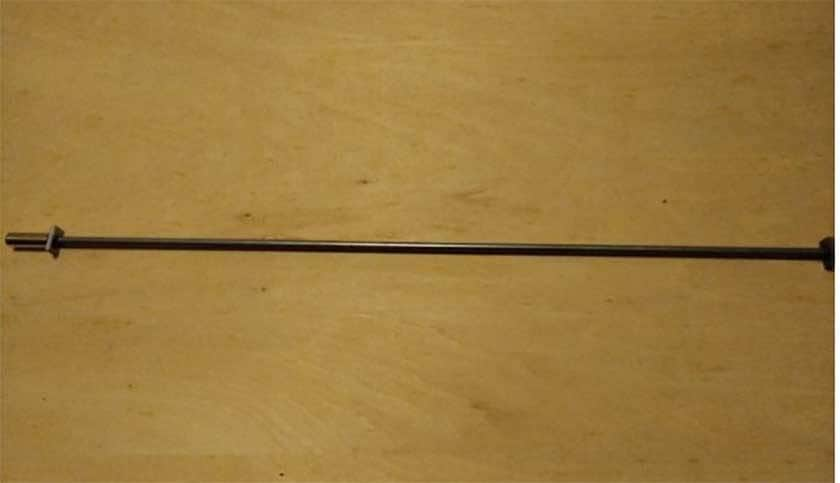
This is the most primitive "adjustable" truss rod, that is, the adjustable truss rod, as shown in the illustration above. The operating principle was explained earlier, and as the name of One-Way suggests, it can basically be used to correct only forward warpage. Depending on the manufacturing process of the instrument, it is possible to have a "pseudo 2-way" effect that slightly corrects reverse warp to the forward warp (reverse warp flattening), but a very large effect cannot be expected. However, due to its simple structure, it is highly reliable, and it is also a great advantage that the kick point (the part where the truss rod has the greatest advantage) can be determined arbitrarily.
2-2. One-Way type (channel rod)
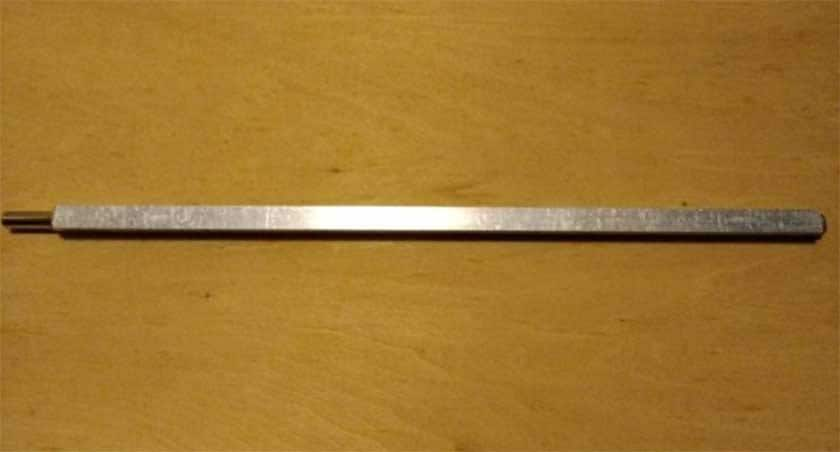
It is an improved version of the truss rod that was only an iron rod, and the strength is improved because the single action rod is incorporated in a U-shaped aluminum rod (aluminum channel). Since the rod in the channel is installed in a curved state from the beginning, a straight groove can be dug in the neck and installed as it is, greatly improving workability during manufacturing. Since it does not require filler wood, it is a type that is appreciated from the production side, but basically it is not possible to make the above-mentioned reverse warp flat surface. It was used in Martin and in some old domestic acoustic guitars until around 2006.
2-3. Two-Way (double action) double rod type
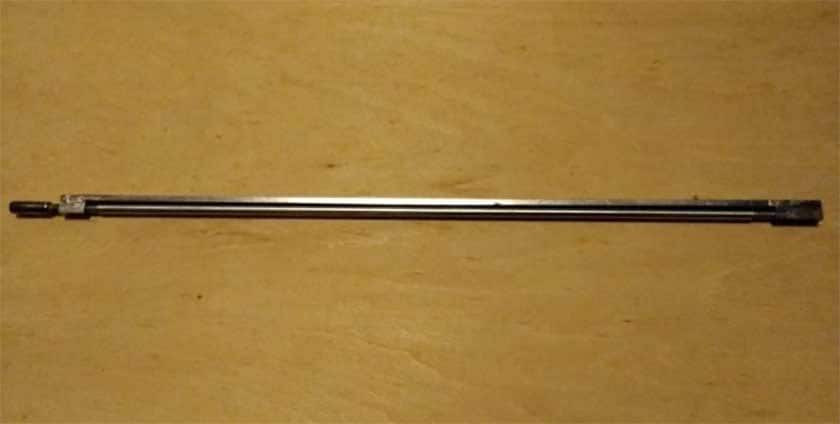

* Masking tape is used to make it easier to understand the warp.
This is an improved version of the 1-way truss rod that can only handle forward warpage, and has the added function of correcting reverse warpage in the forward warp direction as well. The nut is welded to the truss rod body, and it does not come off even if it is turned to the left or right. In addition, by adopting a double rod structure consisting of two metal rods on the top and bottom, the nut can be rotated. It has a structure that can correct the warp by using the difference in length created by the upper and lower rods.
Like the channel rod, it is very convenient because it can be prepared without using filler wood, but if the welded part of each part is loosely constructed, it may break, so the manufacturer side has a hard time choosing the rod manufacturer. There is also a double rod One-way action truss rod with the same appearance and structure as this type, which is confusing, but this can be easily determined by whether or not the nut at the tip can be removed or not.
2-4. 2Way Hot-Rod
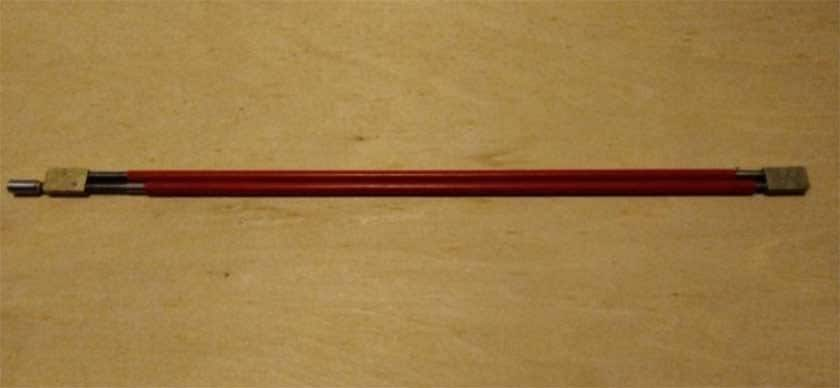
A two-way truss rod that is an improvement of the above double rod type. Using a brass block, the double rod type has three welded points including the nuts, but it is welded in one place to eliminate the difference in strength between the upper and lower rods, which improves strength and durability. It is an improvement. However, there is also the problem that it is difficult to use with a thin neck because it is necessary to dig a deeper groove for the truss rod. However, it’s very reliability, and it seems that many manufacturers prefer it.
2-5. Non-adjustable rod (T bar)
As the name implies, this is a truss rod with a T-shaped cross section. A truss rod that is more primitive than the one-way type that I introduced, and to put it plainly, it is just a T-shaped iron rod. Although it is a fairly strong in terms of resistance to string tension, as the name implies, it cannot be corrected, so if a certain amount of warpage occurs, a large-scale repair such as fret fitting may be required. Other than corrosion, the probability that the truss rod itself will be damaged is almost zero, but since it is necessary to dig a T-shaped groove in the neck, it is a professional spec, and requires troublesome work for the manufacturer. It was used in quite old Martins like the Prewar models.
2-6. Non-adjustable rod (square rod, SQ rod)
"It's a hassle to prepare the T-bar ... No kidding! If you can get the same strength, you don't have to use a T-shape!" So Martin changed the specifications from the T-bar mentioned above in the 1960s. This is the new truss rod. But after all, it's just a square iron rod. Although production has become easier, it can be said that the specifications are for professionals.
The above is a fairly rough explanation of the types of truss rods. There are still various types and materials used for truss rods such as compression rods, ebony rods and titanium rods. Some people say "the rod has a high density inside the neck, so it has a good effect on the sound", but I personally think that an instrument is made up of various elements, so I dare to mention only the above this time. I think it would be interesting to take this opportunity to investigate more on your own, including those areas I left out.






